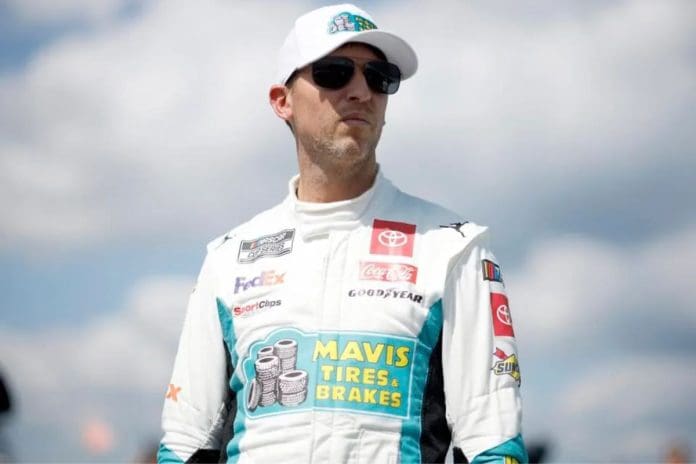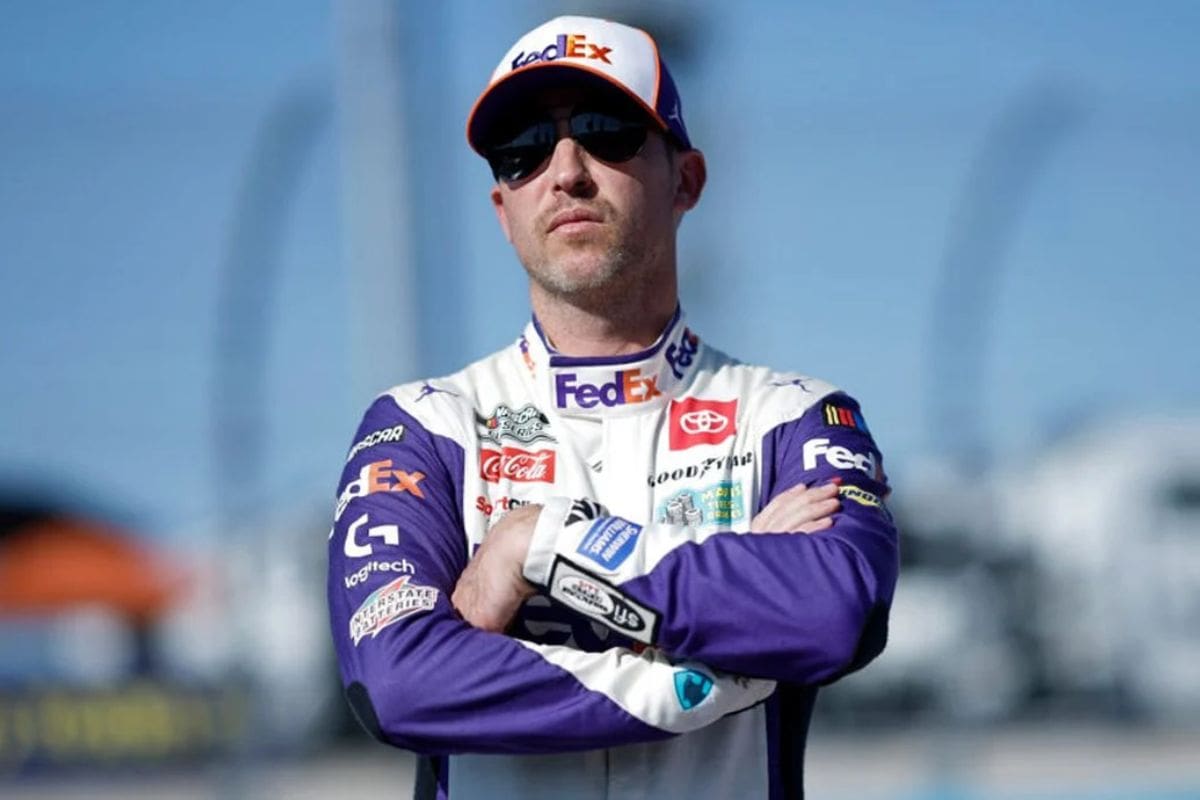Denny Hamlin Exposes Smith-Owned Tracks: Denny Hamlin’s recent critique of the conditions at North Wilkesboro and Sonoma Raceway, both properties of Speedway Motorsports Inc. (SMI), casts a piercing light on underlying issues within NASCAR’s operational and financial frameworks. His pointed observations about maintenance neglect and governance raise significant questions about safety standards, competitive equity, and the xomplex financial interplay between track owners and racing teams. This controversy not only challenges the status quo of NASCAR’s management but also prompts a reevaluation of SMI’s commitment to the sport’s advancement. As stakeholders ponder the implications of Hamlin’s revelations, the broader conversation shifts towards a critical examination of NASCAR’s future direction and its core values.
Key Takeaways
- Denny Hamlin criticized North and Sonoma Raceway, exposing maintenance and safety issues at Smith-owned tracks.
- Hamlin’s critique sparked a wider discussion on the financial dynamics and responsibilities of track owners within NASCAR.
- He highlighted a significant revenue disparity, where teams receive only 25% of broadcast revenues, compared to track owners’ 65%.
- The debate extended to Speedway Motorsports Inc.’s (SMI) investment strategies and their impact on NASCAR’s sustainability and growth.
- Hamlin’s comments prompted a reevaluation of SMI’s role and contributions to NASCAR’s future, emphasizing the need for fairer revenue distribution and better track maintenance.
Denny Hamlin Sparks Controversy Over North Wilkesboro and Sonoma Racetrack Issues
Why did Denny Hamlin’s critique of the conditions at North Wilkesboro and Sonoma Raceway incite such a significant debate among NASCAR enthusiasts and stakeholders? At the core of the controversy was Hamlin’s pointed commentary on social media, particularly concerning the new asphalt at North Wilkesboro. This critique did not merely highlight a physical condition but symbolized deeper systemic issues within NASCAR’s operational and maintenance standards for its racetracks, especially those under the ownership of the Smith family.
Hamlin, as a seasoned driver with substantial influence and a vested interest in the sport’s integrity, leveraged his platform to shed light on what he perceived as negligence. This act of speaking out was not just about track conditions; it was an charge of the governance and stewardship of iconic racing venues. The reaction from the NASCAR community was swift and multifaceted, reflecting a spectrum of opinions on the matter.
For enthusiasts and stakeholders, Hamlin’s critique catalyzed a broader debate on the quality, safety, and competitive fairness of NASCAR venues. His specific concerns about North Wilkesboro’s new asphalt provided a focal point for discussions on track maintenance and race preparation, crucial for driver safety and the authenticity of the sport. This professional and analytical critique by Hamlin prompted a deeper introspection within the NASCAR community, challenging the status quo and advocating for a reevaluation of operational standards and practices within the sport.
Hamlin’s Grievances Extend Beyond Track Conditions
Denny Hamlin’s critique, while initially focused on the physical condition of racetracks, reveals a more profound grievance regarding the financial dynamics between track owners and the broader racing ecosystem. His observations, which aired publicly, shifted from the tangible to the structural, highlighting a discord in the distribution of race earnings. Specifically, Hamlin’s concerns spotlight Speedway Motorsports Inc. (SMI), a key player whose financial practices have drawn scrutiny. The essence of Hamlin’s argument lies in the assertion that SMI, and by extension, other track owners, allocate a disproportionate share of race-generated revenue to their coffers, neglecting necessary reinvestment in track infrastructure.
This critique opens a critical dialogue on track ownership’s responsibilities beyond the mere provision of a racing venue. The implications of Hamlin’s assertions extend to the heart of the sport’s sustainability. A track, after all, is not just asphalt; it is the stage upon which the drama of racing unfolds. The quality of this stage directly impacts the safety and performance of the athletes, the enjoyment of the fans, and, inherently, the integrity of the sport itself.
Hamlin’s grievances, therefore, transcend surface-level concerns, pointing toward a systemic imbalance where financial motivations potentially compromise the core values and long-term health of NASCAR racing. This perspective invites a reassessment of the economic models governing track operations, urging a shift towards practices that prioritize the collective well-being of the racing community over individual profit maximization.
Money Talks: NASCAR Revenue Distribution Debate
The debate surrounding NASCAR’s revenue distribution has intensified, with Hamlin shining a spotlight on the stark imbalance that sees teams grappling with a mere 25% of broadcast revenues, in stark contrast to the 65% pocketed by track owners. This inconsistency not only highlights a significant financial disparity within the sport but also raises questions about the sustainability and long-term health of NASCAR’s competitive ecosystem.
Hamlin’s revelations on his podcast emphasize a critical issue: the financial strain placed on teams due to an arguably outdated revenue model. In an era where the costs of competition continue to escalate, the allocation of broadcast revenues in such a lopsided manner threatens the very fabric of the sport. Teams are the lifeblood of NASCAR, providing the spectacle that attracts fans worldwide, yet they find themselves at a financial disadvantage that could potentially stifle innovation, limit competitive diversity, and deter new entrants.
“My beef kind of with the SMI stuff is actually the opposite beef that I would have with a NASCAR. Well, I don’t… Like, necessarily the chunk of the pie that they take from the teams or would have you or the chunk of the pie that they give to the teams relative to who puts on the show. Nobody goes to the racetrack and watches an empty racetrack they go to watch the stars, the cars, and the teams.” – (Hamlin)
As negotiations for a new deal loom, Hamlin’s advocacy for a fairer revenue distribution is not just a plea for fiscal equity but a strategic move aimed at ensuring the sport’s vibrancy and relevance. The current model, where track owners—often criticized for a lack of reinvestment in the sport—reap disproportionate benefits, is unsustainable in the face of evolving sports entertainment landscapes.
The critical discourse ignited by Hamlin’s comments invites a deeper examination of NASCAR’s business model. A recalibration of revenue sharing could open up new opportunities for growth, bolster team competitiveness, and enhance fan engagement. In the complex interplay of sports economics, the principle that should guide NASCAR’s path forward is clear: a more equitable distribution model is not just fair but essential for the sport’s future prosperity.
Comparing Investments: 23XI Racing vs. Speedway Motorsports Inc.
Amid the heated debate over NASCAR’s revenue distribution, Hamlin’s contrasting of 23XI Racing’s investments with Speedway Motorsports Inc.’s approach sheds light on broader issues of financial commitment and stewardship within the sport. Denny Hamlin and Michael Jordan co-own 23XI Racing, a nascent entity in the NASCAR ecosystem, has quickly established itself as a symbol of proactive investment and innovation. Hamlin’s critique of Speedway Motorsports Inc. (SMI), on the other hand, suggests a disparity in the level of investment and enthusiasm for advancing the sport’s interests.
To understand the essence of Hamlin’s argument, take into account the following:
- Direct Investment in Talent and Technology: 23XI Racing has aggressively pursued top driving talent and invested in cutting-edge technology, signaling a firm belief in building a competitive edge through resource allocation.
- Development of Infrastructure: Despite its relatively short existence, 23XI Racing has shown a commitment to developing its infrastructure, contrasting sharply with Hamlin’s portrayal of SMI’s investment strategy.
- Engagement with Fans and Sponsors: 23XI Racing has actively engaged with fans and sponsors, recognizing their crucial role in the sport’s ecosystem, which Hamlin suggests SMI could better prioritize.
- Contribution to NASCAR’s Growth: People perceive 23XI Racing’s investments as contributing to NASCAR’s overall growth, which raises concerns about SMI’s tangible commitment to the sport’s future.
Hamlin’s comparison invites a deeper analysis of investment philosophies in NASCAR. It challenges stakeholders to ponder the impact of their financial decisions on the sport’s vitality and legacy.
Evaluating SMI’s Role in NASCAR’s Future
In light of Hamlin’s pointed observations, Speedway Motorsports Inc.’s contributions—or lack thereof—to NASCAR’s evolving landscape merit rigorous scrutiny. Hamlin’s remarks spark a critical discourse for NASCAR, emphasizing the need for strategic infrastructural and financial reforms. SMI’s role, as a crucial player, is under the microscope, with its track improvements and revenue distribution policies coming into question.
The heart of the matter lies in the alignment of SMI’s ambitions with the broader objectives of NASCAR’s growth trajectory. Hamlin’s critique emphasizes a perceived disparity in the commitment to nurturing a conducive ecosystem for the sport’s advancement. This discrepancy poses not just a challenge but also an opportunity for introspection and recalibration within SMI’s operational ethos.
Evaluating SMI’s contributions requires a fine understanding of the dynamic interplay between financial investments, fan engagement, and competitive fairness. The allegation of unequal revenue distribution hints at deeper systemic issues that could stifle innovation and equity in the sport. Furthermore, the imperative for track improvements calls for a proactive stance on enhancing the spectator experience and safety standards, which are fundamental to sustaining NASCAR’s appeal and relevance.
Hamlin’s discourse initiates a broader conversation about stewardship within NASCAR’s hierarchy. As the sport stands on the precipice of transformative change, the exigency for SMI to introspect and realign its strategies with the collective vision for NASCAR’s future is paramount. The path forward demands not just introspection but tangible actions that resonate with the aspirations of teams, drivers, and fans equally.
News in Brief
Denny Hamlin’s candid disclosures concerning the state of North Wilkesboro and Sonoma Raceway bring to light a broader debate within NASCAR regarding track safety, equitable revenue distribution, and strategic investments. These revelations necessitate a reassessment of Speedway Motorsports Inc.’s stewardship and its alignment with the sport’s developmental objectives.
The juxtaposition of 23XI Racing’s and SMI’s investment philosophies further highlights the urgent need for a collaborative approach to foster growth, ensuring NASCAR’s vibrancy and sustainability for the future.
Our Reader’s Queries
Q. Who drives number 11 in Nascar?
A. Denny Hamlin, piloting the No. 11 Toyota for Joe Gibbs Racing, also holds a significant stake in 23XI Racing alongside NBA icon Michael Jordan within the NASCAR Cup Series. Hamlin’s track record boasts an impressive 53 victories, highlighted by notable wins in prestigious races such as the Coca-Cola 600 (2022), Daytona 500 (2016, 2019, 2020), and Southern 500 (2010, 2017, 2021).
Q. What year did Denny Hamlin start in Cup Series?
A. In 2005, Denny Hamlin made his NASCAR Cup Series debut at Kansas Speedway under the banner of Joe Gibbs Racing (JGR). He attributes his inaugural opportunity with JGR to the late J.D. Gibbs, as seen in a photograph from 2009.
Q. Is Denny Hamlin a legend?
A. Regarded as one of the premier NASCAR drivers in history, Denny Hamlin stands as a true icon within the sport, earning acclaim as a bona fide superstar.
Q. Is Denny Hamlin a Hall of Famer?
A. Denny Hamlin, at 43 years old, embodies various roles within NASCAR, serving as an entertainer, team owner, and a prospective NASCAR Hall of Famer. Additionally, he sees himself as a steward of the sport’s legacy. Notably, Hamlin previously pursued efforts to organize drivers into a union.
ALSO READ: Denny Hamlin’s Candid Confession: Shocking Revelation Rocks NASCAR!





